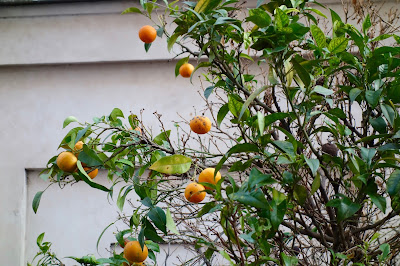 |
| Trevi Fountain |
One of the pleasures of
living in Europe is travel. I’m not
talking about saving for years, planning for years, and finally throwing down a
roll of green for a little bit of travel time.
Nope. Take last weekend’s holidays, for
example. Rome popped into my mind.
Grabbed some cheap airline tickets and reservations at a nice hotel. Cheap tickets? Sure. Only a two-hour flight. They could have packed me in a suitcase and I
would have been ok for two hours. Total
cost for my Thanksgiving Weekend, including airfare and three nights in a great
hotel was about $400.
Fortunately, they did not
pack me in a suitcase. Instead, a kind
flight attendant offered me champagne, with a smile. I almost mistakenly wrote Stewardess, which would have pissed off every woman who has ever had the slightest grudge against any man, dating back to kindergarten.
Properly refreshed, I
settled back to read the complimentary newspaper.
FCO (Leonardo de Vinci)
International Airport is well organized.
Zip zip and you’ve got your bags. Then it’s a short walk to the train
station or Metro Line. Metro is dead simple
to use and the cost for a one-way ticket is about $1.65. But, if you’re going to be in Rome a few
days, you can also buy an extended use ticket.
Another European invention is
the Hop-On Hop-Off bus, available in most major European cities. H-O-H-O takes you on a tour of the city and
lets you jump off wherever you yearn to see the highlights up close, then jump
back on. With buses running every ten to
fifteen minutes, you never have to wait long.
Cost is about $20 for a 24 hour ticket.
 |
| Part of Palatine Hill |
Rome, you will quickly
realize, is a city built on the ruins of a city that was also built on ruins,
which was built on….ok, you get it. From
those rare lucid moments in European History Class, you may vaguely remember
the ancient Roman civilization lasted for twelve centuries. It's broken down into
three periods: Kingdom (753 BC – 509 BC), Republic (509 BC – 27 BC) and the one
we know best, Empire (27 BC – 476 AD).
The Empire, of course, is best remembered for all the conquering and all
the famous Caesars. (Julius, Augustus, Nero, Caligula, etc).
But, first things
first. Who established Rome? One answer is the well established myth
of Romulus and Remus. Half god, half
human, the brothers were raised by a she-wolf, but later argued on which part
of Rome should actually be Rome and Romulus killed Remus, which set the stage
for future bloody episodes in Roman history.
Please keep in mind, that
what I’m offering here is a glimpse and ONLY a glimpse of Rome. Hey, I was only there a weekend and according
to this guide and that, a particular edifice could have had three or four different
‘famous’ architects over the centuries.
When the names I’ve never heard of spewed like water from the Trevi
Fountain (yes, I recognized that one!) I became bewildered and sought
quantities of wine.
So, many of the photos are
just ‘life in the city’ photos, a peek into what the streets are like. But, I do have a bit more to offer.
 |
| Had Gelato? Not until you've had it here!!! |
 |
| Cool sidewalk cafés abound |
 |
| Parking Roman Style |
 |
| Many orange trees in the heart of the city |
 |
| Yes, it's a city of scooters! |
Let’s chat about Fontana di
Trevi for a sec. Trevi is at the
juncture of three roads (tre vie) and marks the end of one of the major
aqueducts that supplied water to the city of Rome. Legend has it a virgin helped the engineers
find pure water about 13 miles from the city. They then built the aqueduct. No
history about what happened to the virgin, but I’m guessing she made a good
living as a pure water gal, but often lacked for male companionship. It’s a give and take world.
How about the Colosseum or
Coliseum? Completed in 80 AD, it held
50-80,000 people and was used for entertainment on a grand scale, including
reenactments of battles, both land and sea, plus lots of killing sports. Unlike the Circus Maximus (150,000 people
watched chariot racing), the Coliseum didn’t see much killing of Christians, or
so I’ve heard.
 |
| The Coliseum |
Then there’s the Palatine
Hill (photos below), the centermost hill of Rome (remember, there are seven), which overlooks
the Circus Maximus on one side and the Forum on the other. This is supposedly the hill where Romulus and
Remus founded the city. Now it’s a vast
collection of rubble, the ruins of multitudinous temples to every god
imaginable. I roamed this place for two
hours and didn’t see it all. Finding
your way out is part of the frustrating game of “Let’s see the rest of Rome.”
 |
| The Arch of Titus commemorating the siege of Jerusalem, 81 AD |
 |
| Gotta be careful when you drive your chariots on those Roman roads. One small slip and you could bust your axle. |
So much I didn’t see. I don’t know how many lifetimes it would take
to learn about Rome, street to street.
There’s the Vatican, just to name one.
Did you know Vatican City State is it’s own country? Just 110 acres and with 842 inhabitants, it’s
the smallest sovereign state in the world.
Ok. Ok. Enough.
Time for more wine. Just a quick
question: If a virgin helped the Romans
find pure water, who helped them stomp the first grapes? I know what you’re thinking, “Who gives a
damn, just shut up and pour!” Salute!




























